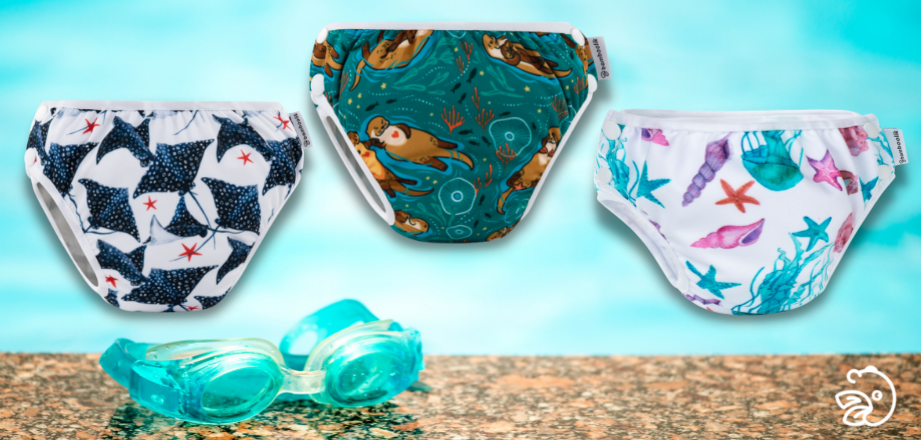5 tips for baby swimming lessons
How to raise a water loving baby? No, we don’t mean a tiny Michael Phelps, that would be way too ambitious. We’re talking about a respectful approach to water, about a baby who won’t start crying every time water splashes in their eyes. A baby that doesn’t mind having their hair washed. Enjoy water play with your baby using our helpful tips!
1. Just enjoy
Take it easy. Surely, there are babies who are born water lovers, who love to splash around and water in their face makes them laugh. But there are also babies who are naturally much more cautious when it comes to water.
We recommend introducing water soon, but slowly. Start with making bath time a habit. Check the temperature in the room (should be just fine, not too cold, not too hot) as well as of the water (approx. 37°C). Gently lay your baby in the bath, pay close attention to what they’re doing and react accordingly. If your little one is happily kicking around, with water splashing in their face, great! If a wet face is not your baby’s cup of tea, try taking tiny steps at first — for example gently wipe your baby’s face with a wet cloth and see what happens.
All babies have inherent diving reflex. If their head sinks under water, they automatically hold their breath for a moment. This reflex fades away around 6 months of age but if you keep training it, it might seamlessly become a learned skill.
2. Baby swimming lessons
As with any sport, start them young :-) If your baby is used to being in the water since as long as they can remember, it’s very unlikely that they would start being afraid of water later in life.
Baby swimming lessons are a great practice. Children at just 6 months can attend and the main purpose of these lessons is to teach the baby students how to safely move around in water. Various swimming exercises are often accompanied by nursery songs and rhymes and playful teaching tools are used, teaching your baby some basic swimming skills.
Don’t be surprised when your little swimmer starts to swim underwater first! That happens as it’s much easier than swimming their head up.
3. Bath time at home
If organized baby swimming lessons are not your thing, try to replicate them in the comfort of your own home. It works, too.
Bathe together! As with everything else, babies learn by imitation. Also, get the most of the time with your baby while you can — you have just a few years, you know? Enjoy bath time together before your offspring tells you to leave them alone :-)
Be silly: Pour a cup of water on your own head and laugh about it. Then try to do the same to your baby. We bet they’ll laugh, too (make sure to be the first to laugh and your baby will most likely follow suit). Gently pouring water on your baby’s head is a great way to make your baby get used to water on their face.
There are so many water toys — use them! Circles, flexible rubber poles, inflatable balloons.... Mugs and cups are also immensely popular, as ordinary as it may sound :-) We know babies who could play for hours with empty yoghurt cups — very inexpensive and very effective.
4. Winter preparation
Half a year is such a long time for a baby. If your baby loved water play last summer when they were 6 months old and then their contact with water was limited to a quick shower for the following 9 months, it should come as no surprise that their approach to water might be not so enthusiastic this year.
The reason for that is clear — they forgot! That’s why we recommend taking longer baths even during colder months and go to the swimming pool from time to time even in winter. Practice makes perfect.
5. Swim diapers
You probably won’t worry about swim diapers for your baby in your own pool or by a lake. We recommend it, go natural!
However, public pools have rules you need to follow and babies need to wear swim diapers there, due to hygienic reasons. Remember: There are NO swim diapers that could prevent urine from mixing with the pool water. That is just not physically possible. Swim diapers are there to catch poop.
Because of this, we don’t understand why some disposable swim diapers have an “absorbing” layer. It’s pointless. The only thing it does when submerged in a water, is to quickly absorb all the water to its maximal capacity, immediately becoming a burden between the legs. And then it just gets in the way, making the entire swimming experience not very comfortable for your baby.
For a swim diaper to be useful and comfortable, we recommend:
- choose a swim diaper without any absorbing layer,
- preferably with soft hems that don’t scratch,
- pay attention to size: a swim diaper should cling tight to the body and shouldn’t be too big around the waist or around the legs (it helps when the size is adjustable),
- inquire about the fabric of the swim diaper — it should ideally be breathable and quick-drying.
Check our swim diapers made of breathable PUL. They’re available in three sizes (each size can be adjusted according to your needs) and made in Europe from European materials. Because we believe in sustainability in all aspects of our production.
And this is how little Matthew enjoyed water play in our swim diapers when he was about 9 months old.


